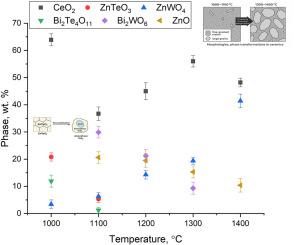多组分复合陶瓷热障防护涂层应用前景的确定
IF 2.8
Q1 MATERIALS SCIENCE, CERAMICS
引用次数: 0
摘要
本文介绍了热烧结条件变化对铈、碲、铋、钨和锌氧化物复合材料多组分陶瓷相变过程影响的实验结果。根据所得数据确定,在退火温度高于1000℃时,观察到的钨酸锌夹杂物的生长是由于ZnTeO3相和Bi₂WO₆相的再结晶过程,导致ZnWO4相晶粒长大,形成具有增强作用的玻璃状夹杂物。在进行的研究中,确定了在多组分陶瓷的组成中,由于烧结的热效应而形成的钨酸锌形式的夹杂物,导致陶瓷对外界影响的抵抗力增加,同时也增强了对高温破坏和氢化过程的抵抗力。对所研究陶瓷的保温特性分析表明,钨酸锌夹杂物在陶瓷成分中占主导地位,导致陶瓷对氢化破坏和热老化过程的抵抗能力增强,长期的氢化破坏和热老化的影响导致陶瓷强度性能的不稳定性增加,保温性能恶化。本文章由计算机程序翻译,如有差异,请以英文原文为准。

Determination of the prospects for the use of multicomponent composite ceramics as thermal barrier protective coatings
The paper presents the results of experiments aimed at identification of the influence of variations in thermal sintering conditions on the phase transformation processes in multicomponent ceramics based on oxide compounds of cerium, tellurium, bismuth, tungsten and zinc. According to the data obtained, it was established that with the annealing temperature growth above 1000 °C, the observed growth of zinc tungstate inclusions is due to the processes of recrystallization of the ZnTeO3 and Bi₂WO₆ phases, which lead to the growth of grains of the ZnWO4 phase and the formation of glass-like inclusions that have a reinforcing effect. During the studies conducted it was determined that the formation of inclusions in the form of zinc tungstate in the composition of multicomponent ceramics, caused by the thermal effect of sintering, leads to an increase in the resistance of ceramics to external influences, and also enhances resistance to high-temperature destruction and hydrogenation processes. An analysis of the thermal insulation characteristics of the studied ceramics showed that the dominance of zinc tungstate inclusions in the composition of the ceramics leads to increased resistance to both the processes of destruction caused by hydrogenation and thermal aging, the long-term impact of which leads to increased destabilization of the strength properties of the ceramics and deterioration of thermal insulation.
求助全文
通过发布文献求助,成功后即可免费获取论文全文。
去求助
来源期刊

Open Ceramics
Materials Science-Materials Chemistry
CiteScore
4.20
自引率
0.00%
发文量
102
审稿时长
67 days
 求助内容:
求助内容: 应助结果提醒方式:
应助结果提醒方式:


